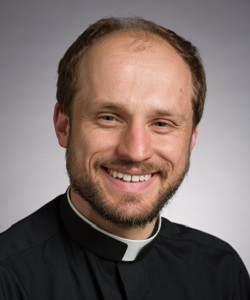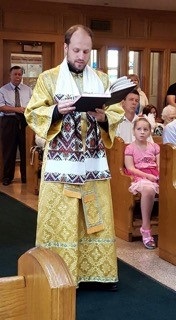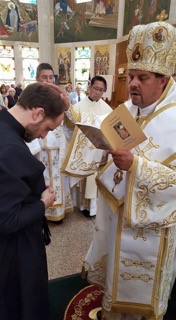
By Brian Harper
Many Catholics might be be surprised to learn their faith comprises 24 distinct Churches. While most Catholics are familiar with the Latin Church, there are 23 Eastern Catholic Churches with their own theological, spiritual, liturgical, and juridical traditions.
Midwest Jesuit scholastic Andrij Hlabse, SJ, is Ukrainian Greek Catholic, a member of one of the Eastern Catholic Churches. Upon ordination, Andrij will become a priest with bi-ritual faculties, allowing him to celebrate the Holy Eucharist in two different traditions: the Divine Liturgy in the Greek Catholic tradition and the Mass in the Latin tradition.
Last summer, Andrij was ordained as a lector, cantor, and subdeacon in the Ukrainian Greek Catholic Church. Now studying theology in Rome, Andrij reflected on his faith formation as a child, the “universality” of his Jesuit vocation, and how he hopes to serve God’s people.
|
|

|
|
|
Andrij Hlabse, SJ, at his ordination to the Minor Orders of lector, cantor, and subdeacon |
Q: How did you come to join the Jesuits?
I joined the Society primarily through relationships I had with Jesuits, starting at Saint Ignatius High School in Cleveland. I already had a sense I was called to be a priest, and meeting Jesuits who taught; traveled; knew history, language, and culture; and lived a life free for the Gospel deeply inspired me. I also met Jesuits while at the University of Notre Dame, and that still, small, interior voice calling me to become a Jesuit never left me. I came to know the Jesuit community at Saint Ignatius better yet when I volunteered there for a year after my undergraduate studies. Over time, I perceived God’s personal call more clearly and responded.
Q: What led you to a Jesuit vocation tied to the Ukrainian Greek Catholic tradition?
My father is Slovenian and a Latin Catholic; my mother is Ukrainian and a Ukrainian Greek Catholic. My family, including my brothers and me, had a strong faith, informed in great part by the oppression my relatives faced from Communist regimes in Europe. Because I was raised in a family that embraced both Eastern and Western traditions, I quickly felt at home sharing in two traditions within the Catholic Church — the Ukrainian and Latin.
One of the reasons I was attracted to the Jesuits was because, unlike for some other religious orders, a Jesuit is permitted to belong to any of the Eastern Catholic Churches or to the Latin Church. Although my tradition is uncommon compared with many of my Jesuit brothers in the United States, the Society and my superiors are very encouraging of my Eastern Catholic identity. They recognize the gift it can be to the Church. Pope Saint John Paul II wanted the Catholic Church to “breathe with both lungs,” the Eastern and Western. My vocation helps me to do that.

|
|
| Andrij Hlabse, SJ, with the Most Reverend Bohdan J. Danylo, bishop of St. Josaphat Cathedral in Parma, Ohio |
|
Q: What are some of the distinctions between the Eastern Catholic and Latin Churches?
The 23 non-Latin Churches are called the Eastern Catholic Churches. They can be classified according to their liturgical traditions. The Byzantine tradition is one of these and includes the Ukrainian Greek Catholic Church. The Byzantine liturgy is characterized by sung prayer, litanies, iconography, and a full sensorial worship experience that has the same roots as the Eastern Orthodox Christian tradition.
Eastern Catholics can be found around the world due to various migrations, like my ancestors’ move to Cleveland after World War II. Today, they are among those most under threat for their faith in the Middle East. Still, they offer a profoundly rich source of theological, historical, and spiritual wisdom.
Personally, Byzantine worship has helped me to appreciate sacred music, as well as sacred art and architecture, as effective vehicles to build the faith of God’s people and proclaim Christ in the modern world. I believe the Byzantine tradition has much to contribute to the evangelization of the contemporary world. It draws a great deal of its wisdom from outstanding bishops and theologians of the early Church. I hope to learn these ancient theologians well in my studies in Rome and to build on their foundation of wisdom.
Q: How was the experience of being ordained as a lector, cantor, and subdeacon in the Ukrainian Church?
My ordination to the subdeaconate was important and moving, because it is the first official, canonical step I have made toward the priesthood since my first vows. It was a joyful occasion and a reminder of the kind of service to which I have committed myself.
Because of the blessings of my ethnic and multi-ritual upbringing, I am positioned to give myself in a “universal” way — to people of different languages, countries, and even different Churches — to an ever-expanding group of people who can hear the Gospel. I am very grateful to God for this gift of “universality” in my Jesuit vocation and recognize how close to the heart of Saint Ignatius this gift is.